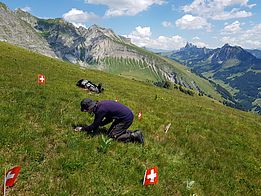Dry grasslands harbour many rare and threatened plant species. More than 3,600 of such grasslands have been protected in Switzerland . Researchers from the WSL Swiss Federal Research Institute now found that grassland conservation measures seem to be largely successful in lowland regions. However, in particular at higher elevations the quality of these species-rich habitats is still declining.
Dry grasslands are highly species-rich habitats that rely on extensive agricultural use. However, with the intensification of agriculture, 95% of them have disappeared since the start of the 20th century. To protect the remaining ones, over 3,600 dry meadows and pastures of national importance have been protected since 1995, when the vegetation in more than 10,000 28m2 plots was sampled. WSL researchers have now repeated this vegetation check at more than 500 of these sites in order to test for potential changes along ecological gradients.
In lowland areas, the habitat quality of dry grasslands largely remained constant, suggesting that the conservation measures have been successful. In contrast, the habitat quality of the particularly species-rich grasslands at higher elevations declined. The researchers reported their findings in the scientific journal Tuexenia and the specialist journals N+L Inside and Flora CH. "If we compare our data with the inventory data from two decades ago, the vegetation indicates a decreased habitat quality, particularly of the species-rich high-elevation dry grasslands," says WSL researcher Steffen Boch.
More intensive use – or none at all
If fertiliser is applied to a grassland to increase the hay yield, the species composition of the vegetation changes. Particularly nutrient-loving, mainly common and widely distributed are promoted and can outcompete low-statured dry-grassland species that favour nutrient-poor conditions. While fertilisation and irrigation are banned from designated dry grasslands in Switzerland, it may well be that airborne nutrients from the intensively used surroundings are deposited in protected areas, which might lead to vegetation changes.
Conversely, the abandonment of agricultural use is a second major grassland threat. If grasslands are no longer mown or grazed, woody species, i.e. shrubs and trees invade and can displace the typical dry-grassland vegetation. In the scientific journal Flora, the researchers therefore recommend cutting of woody species and maintain extensive grassland use such as extensive grazing or annual low-frequency mowing.




Contact ¶
Links and publications ¶
N+L Inside:
Boch S, Bedolla A, Ecker KT, Graf U, Küchler H, Küchler M, Holderegger R, Bergamini A (2019) Trockenwiesen und -weiden verändern sich in hohen Lagen stärker als im Tiefland. Natur & Landschaft Inside (KBNL) 19(2)
Copyright ¶
WSL and SLF provide image and sound material free of charge for use in the context of press contributions in connection with this media release. The transfer of this material to image, sound and/or video databases and the sale of the material by third parties are not permitted.

